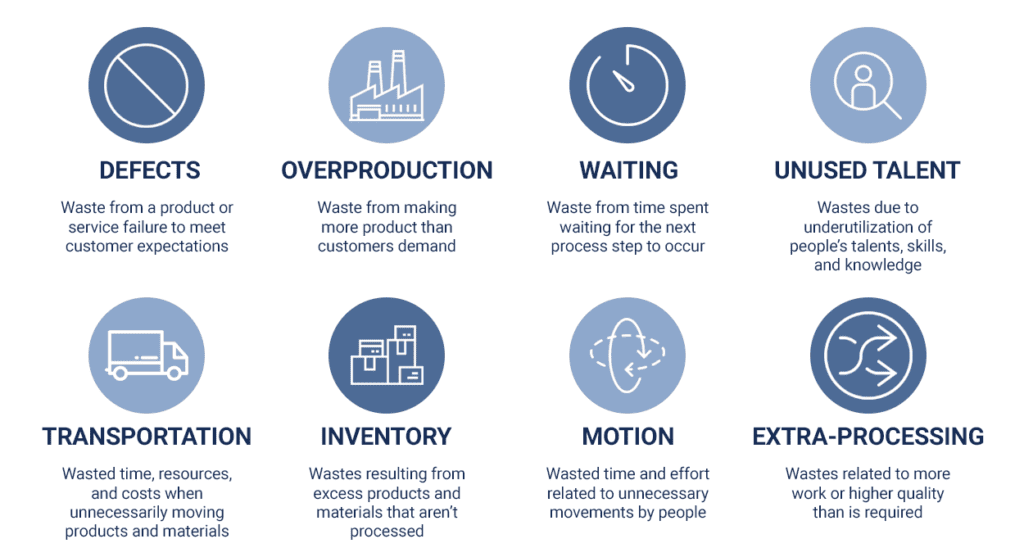Table of contents
What are the 8 Wastes of LEAN Manufacturing?
LEAN thinking is a way to eliminate waste from work processes. It is important to first understand what waste is before you dive into these 8 types of waste in lean manufacturing. Any action or step that doesn’t add value for the customer is considered a waste. Waste is simply any process the customer doesn’t want to pay for.
Taiichi Ohno (Chief Engineer at Toyota) developed the original seven wastes (Muda), as part of the Toyota Production System. These seven wastes include Transportation, Inventory and Motion, Defects, Overproduction, Overprocessing, Waiting, Waiting, Overproduction, and Overprocessing. These seven wastes are commonly referred to by the acronym TIMWOOD. In the 1990s, the Toyota Production System was introduced to the West. This was when the 8th waste of Skills was introduced, since before there were only 7 wastes in lean manufacturing. These 8 wastes are often referred to collectively as “TIMWOODS”.
The 8 Wastes of LEAN

1- Transportation
Transportation waste includes the movement of people, goods, tools, inventory, and equipment that is more than is necessary. Product damage and defects can be caused by the excessive movement of materials. Excessive movement of equipment and people can also lead to increased wear and tear and exhaustion.
Workers who work together often in the office should be near one another. Material needed for production in a factory should be readily accessible at the location of production. Double or triple handling should be avoided.
One of the countermeasures against transportation waste is to develop a U-shape manufacturing line, create a flow between processes, and not over-produce work in process (WIP).
2. Inventory
Because of the holding costs, inventory is considered waste. This applies to raw materials, WIP, and finished goods. Inventory waste can be caused by overbuying or poor planning and forecasting. It may also signal a broken or poorly designed process link between operations and purchasing/scheduling. LEAN is not limited to operations. It also involves process optimization and communication among support functions.
Forecasting, purchasing, and scheduling can all be done in a standardized way. This is accomplished by defining minimums and maximums as well as order points. These points are then mapped to the process flow. This type of waste can be reduced by purchasing only the necessary, reducing WIP, and narrowing or eliminating the definition of “safety stocks”.
3. Motion
Money is spent on the waste of motion. This does not just include raw materials, but also people and equipment. This could also include excessive physical motion like reaching, lifting, and bending. Any unnecessary motion increases costs and results in a loss of value.
Process mapping, which is based on the core LEAN methodology, should include workplace layout and optimization. This includes analysis of distances within the space and the locations of parts, supplies, and tools within it. With well-designed and documented standard work, you can capture the space’s full potential with a process map.
4. Waiting
Waste of waiting refers to people who are waiting for material or equipment; and idle equipment. Uneven production lines can lead to long waiting times. This can cause excess inventory or overproduction.
The waste of Waiting in the office can be waiting for someone to reply to an email, having files awaiting review, ineffective meetings, and waiting for the computer to load a program. Waiting for waste in a manufacturing plant can mean waiting for materials to arrive and waiting for the correct instructions to start manufacturing.
There are several countermeasures to waiting. These include designing processes that ensure continuous flow or one-piece flow, leveling the workload using standard work instructions, and creating flexible multi-skilled workers capable of quickly adapting to changing work demands.
5. Overproduction
Overproduction happens when sub-components of a process or service are made before they are needed by downstream processes. Overproduction can have several negative consequences. It causes a “caterpillar effect” in the production flow, which results in excess WIP. This can lead to additional staging and labor needed to move the WIP further. It can conceal defects that could be caught earlier if the processes were balanced so that the defect could have been detected earlier. If the defect had been discovered in time, the WIP components could have been used to correct it.
To reduce overproduction, LEAN systems use several tools. Takt time is used for balancing rates across cells and departments. Process-mapped jobs and measured jobs allow for faster setup times, which allows for efficient small batch flow. Kanban, a pull system that can be used in many industries to control or eliminate work in progress, is a common tool.
6. Over-processing
Over-processing is when you do more work, add more components, or have more steps than the customer requires. This could be done by using higher precision equipment, using components that have greater capacities than required, running more analyses than necessary, over-engineering solutions, changing a component after it is installed, and adding more functionality to a product. Over-processing in the office can mean that you generate more detailed reports than necessary, require more signatures, double-enter data, have more forms than required, or add an extra step to a workflow.
Understanding the customer’s needs is an effortless way to avoid over-processing. Before you start work, always keep the customer in mind. Produce to the standard and expectations of the customer and only make the quantity required.
7. Defects
Defects can impact customer satisfaction, time, money, and resources. Production environment defects include poor documentation, inconsistent inventory levels, poor design, and changes to related documentation.
Effective ways to reduce defect waste include formalized document control, design change documentation, detailed and documented quality procedures in all production phases, and checklists that have been audited for compliance. Standardized work in every department, cell, and point of the production line will also help to reduce this type of lean waste.
8. Skills
Although it wasn’t part of the Toyota Production System (TPS), which recognizes 7 types of waste in lean manufacturing, many people know about the 8th waste, the waste of human potential. The 8th is also known as the waste of ingenuity and human talent. This is when management and employees are separated. Management’s role in some companies is to plan, organize, control, and innovate the production process. The role of the employee is to follow instructions and complete work according to a plan. It is hard to improve processes if you don’t engage the knowledge and expertise of frontline workers. This is because the people who do the work are the most skilled at identifying and solving problems.
Poor training, insufficient incentives, not asking employees for feedback, and placing employees in jobs that are below their qualifications and skills could all be examples of non-utilized talent in the workplace. This waste in manufacturing can be seen in employees who aren’t properly trained, don’t know how to operate equipment effectively, or are given the wrong tool. Employees are also not challenged to think of ways to improve their work.
How to Identify The 8 Wastes

Recognizing that there is waste is the first step in reducing it and creating a process to identify it. Value Stream Mapping is a LEAN management technique that analyzes the current state and designs a future one. It tracks the information flow and materials as they happen. VSM can be used to map out production processes, show the relationship between them visually, and separate value-added from non-value-added activities.
Use the VSM to identify waste and begin with the customer. From the end customer, work backward to the beginning of the production processes. Record the eight wastes and create a plan to eliminate or reduce them. Your team should continue to challenge you to identify more waste and continually improve their processes. Get to know your frontline workers and get their suggestions for improvement. Your team will become more confident in their ability to solve problems and reduce waste as a daily part of their day as they begin to reduce efficiencies.
Want to become an expert at spotting the 8 wastes of Lean?
Start your Lean Six Sigma certification today!



















